Athletic preparation for crossfit: ensuring performance while preventing injury

CrossFit training has rapidly gained popularity as a comprehensive, challenging and engaging fitness programme. It is based on high-intensity training that combines strength with endurance and gymnastics exercises, and requires comprehensive athletic preparation for optimal performance and, most importantly, injury prevention.
In this article, we will explore the fundamentals of athletic preparation in CrossFit and provide practical tips for improving performance and physical ability without incurring unpleasant overloads.
What are the fundamental movements and exercises in CrossFit?
CrossFit is based on a combination of functional movements performed at high intensity. These movements can include Olympic weightlifting, gymnastics, running, jumping, throwing and more. Athletic preparation in CrossFit therefore focuses on several key elements:
- Strength: Strength is crucial in CrossFit, to ensure that complex movements are performed correctly, and is the basis for generating power. Olympic weightlifting exercises such as squats, deadlifts and clean & jerk are fundamental in building functional strength for this discipline.
- Endurance: cardiovascular and muscular endurance are essential for sustaining the intense and prolonged workouts that CrossFit involves. High-intensity training (HIIT) and exercise circuits are used to improve endurance and increase muscle work capacity.
- Power: the ability to generate power is crucial for performing explosive movements such as clean and jerk and snatch. Plyometric exercises and speed workouts are used to develop muscle power.
- Coordination: CrossFit requires agility and balance to quickly perform transitions between different movements and to maintain stability during exercises. Balance and coordination exercises are integrated into athletic training to improve these skills.
- Flexibility: good joint mobility and flexibility are essential to ensure that CrossFit movements are performed correctly and to prevent injuries. Stretching and mobility exercises are included in athletic training to improve range of motion and joint stability.
Injury prevention programme: why it is essential for CrossFitters
CrossFit is a sport in its own right and, as such, requires specific athletic preparation, as well as a proper injury prevention programme.
However, a distinction has to be made between CrossFit athletes who have performance as their goal, and are therefore aware of the risks that certain joint stresses may entail in the long run, and those who practise this discipline for fun, to stay fit and challenge themselves. This latter category of amateur CrossFitters needs special attention and correct progression in order to avoid injuries that may interrupt or slow down the expected progress of training.
In a previous article, we took a close look at the most common CrossFit injuries and how to prevent them. Remember that the risk of musculoskeletal injuries can be averted if you follow a few basic precautions:
- Calibrating workouts to suit the physical abilities of the individual and with the necessary facilitations, adapting them, for example, to newcomers who are less used to physical activity and are less prepared.
- Devising a proper combined activation programme before the workout, consisting of stretching, cardiovascular exercises of gradually increasing intensity and a joint mobility routine to better prepare for the workout.
- Planning a collateral injury prevention programme focused on the joints that are most commonly stressed in CrossFit (e.g. shoulder and spine), but also on the specific aspects of the individual.
How to set up athletic preparation and improve performance
Let’s now look at a series of aspects that should not be underestimated when engaging in an athletic programme intended to improve performance in CrossFit.
- Planning: It is essential to have a well-structured training programme that includes a variety of exercises and training modes to develop all components of athletic preparation. In CrossFit centres, the workouts are often standardised and based on a common schedule for all members. This can be fine as long as the correct regression and anatomical adaptation phases are planned and implemented for newcomers or people who have been inactive for a certain time.
- Progression: in order to prevent overtraining and injuries, the intensity and frequency of training must be increased gradually while respecting the muscular, mental and physical adaptation times. Consistency is the key to success, so overly rapid progressions are not recommended as they are difficult to sustain in the long term.
- Recovery: by recovery we don’t just mean the time that elapses (hours or days) between sessions. The body needs to recover and adapt to the stresses of training. To do this, you need to sleep well (in terms of quantity and quality), have a balanced diet, hydrate adequately to replenish mineral salts, and if necessary take supplements to support muscle gain, along with specific post-workout products. All under the guidance of an experienced sports nutritionist if possible. Many athletes are, without realising it, perpetually overtrained, constantly performing below their capabilities and exponentially increasing the risk of injury. These individuals usually realise this after a few days of inactivity, when they find themselves performing significantly better.
- Variety: it is very important, while sticking to a precise schedule, to vary exercises and training modes in order to continuously stimulate muscular adaptation and prevent over-adaptation.
Maximising performance in CrossFit: training tips
Let’s now take a look at some essential aspects and some of the suggested training methods for improving athletic ability and maximising performance in CrossFit.
Increasing Maximum Strength
Maximum strength is already trainable with a regime of around 90% of 1RM. This will allow the athlete to be more protected by subjecting him/her to loads that are slightly below the maximum, but still train this capacity. The method we suggest for experienced athletes involves training with sets to muscle failure at 90% of your maximum after an adequate warm-up. The target exercise is usually a basic one, such as a Flat Bench or Squat. The repetitions will initially be around 3-4. After an incomplete recovery phase of approximately 60″, repeat the series to failure with the same load. Continue until you can perform more than one repetition. Now perform a full recovery of 3 minutes and start again. Repeat in 3-5 blocks depending on the time available. The load should not be varied during training.
Increasing Muscle Stamina
To increase muscle stamina, we can take a CrossFit workout, reduce the volume by about 25 per cent and perform it at maximum intensity. Once completed, athletes should take a break of at least 5 minutes and then repeat the same workout. As a result, they will be working on a volume 1.5 times the competition volume, but the intensity required within the two fractions should be slightly higher than the competition volume, in order to accustom the athlete’s muscles and mind to being above their threshold and thus their comfort zone.
Training Aerobic Endurance
In CrossFit training, the intensity required is high. Endurance workouts are often between 5′ and 10′, only in some cases exceeding 20′. However, it is useful to include lower intensity cardio workouts that predominantly utilise aerobic metabolism. We recommend including running or swimming sessions lasting longer than 30 minutes in your weekly programme, within which you can work at a constant pace or provide for variations in pace.
Providing for an effective activation phase
Pre-training has a dual purpose: to ensure better preparation for working out and prevent injuries. Proper activation must include a cardiovascular warm-up at a progressive intensity of between 7 and 10 minutes. Following this, we suggest a joint mobility stage, selecting 3-4 dynamic exercises associated with some of the gestures envisaged in the workout and working on the individual athlete’s “weak spots”. As a final step, we suggest including 3-4 injury prevention exercises to ensure specific strengthening of some very important areas, such as the rotator cuff, hip abductors and core muscles.


